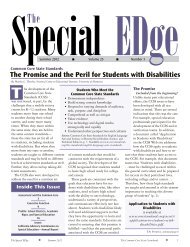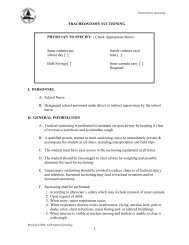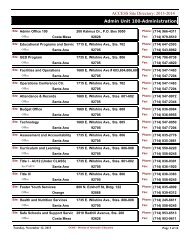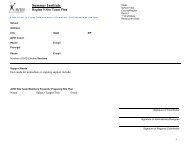View PDF
View PDF
View PDF
You also want an ePaper? Increase the reach of your titles
YUMPU automatically turns print PDFs into web optimized ePapers that Google loves.
2 0 1 2 – 1 3 C a l i f o r n i a P h y s i c a l F i t n e s s T e s t ( P F T )<br />
Warning Flags (continued)<br />
• Skinfold Measurements – Both triceps and calf skinfold measurements are needed to<br />
calculate percent body fat. Incomplete data is scored Insufficient (I) and reported as Needs<br />
Improvement.<br />
• Back-Saver Sit and Reach and Shoulder Stretch – Both left and right sides are needed to<br />
calculate flexibility score. Incomplete data is scored Insufficient (I) and reported as Needs<br />
Improvement.<br />
Additional Considerations<br />
The system does not flag errors or warnings with any of the data, which results in<br />
an unusually high or low calculated score (i.e., VO 2<br />
max, Body Mass Index [BMI], or<br />
percent body fat).<br />
One-Mile Run and PACER – Students ages 10 and above with times greater than<br />
13 minutes on the One-Mile Run or scores less than 10 laps on the PACER, will not<br />
have a VO 2<br />
max calculated. (These students are reported as Needs Improvement.)<br />
Students age 9 with time or laps reported have a VO 2<br />
max calculated and are<br />
compared to the HFZ for students age 10. If a One-Mile Run time or PACER laps<br />
are reported for students less than age 9, a VO 2<br />
max will not be calculated, but the<br />
student will be reported in the HFZ.<br />
Scoring Data<br />
A key component of the scoring process involves the calculation of the student’s<br />
age, VO 2<br />
max for Aerobic Capacity (i.e., the One-Mile Run, PACER, and Walk Test),<br />
BMI, or percent body fat for Skinfold Measurements. All of the equations used in<br />
these calculations are included in the 2012–13 PFT Reference Guide available on<br />
the Resources page of the California PFT Web site at http://www.pftdata.org/.<br />
Age Calculations<br />
The student’s age must be calculated as part of the PFT scoring because the HFZ<br />
for most test options vary by age. Calculating a student’s age involves taking the<br />
difference between the Date of Birth and the PFT Start Date or the April 1 default<br />
(which is applied to students for whom a PFT Start Date is not provided or is a date<br />
beyond May 31). This calculation is based on 365.25 days in a year. If the resulting<br />
age has a decimal, it is truncated (i.e., it is not rounded up). To ensure the student’s<br />
age at the time of the PFT administration is as accurate as possible, it is important<br />
that the PFT Start Date be reported. Applying the April 1 default test date could<br />
result in overestimating or underestimating a student’s age.<br />
PFT Coordinator Manual 41 California Department of Education • November 2012
















